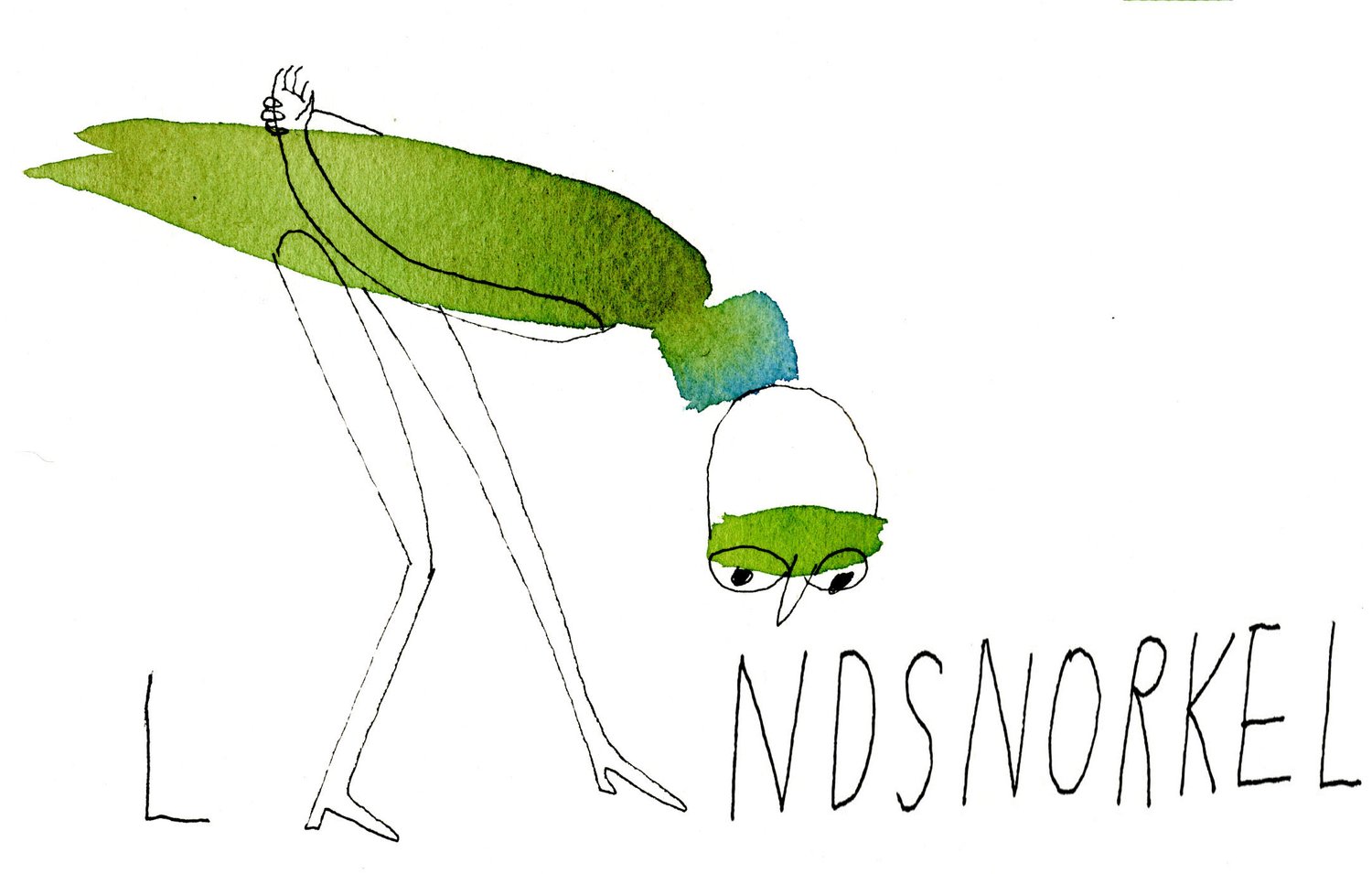What's in a Name?
Original Article here on Gallatin Valley Land Trust.By Whitney TiltIf only someone had mentioned that Latin might be useful one day. In elementary school, attempting to study Latin, my classmates and I often complained, “Latin killed the Romans, and now it’s killing us.” Beyond Amo, Amas, Amat, I was pretty well lost. Later in high school, class mates of mine actually studied Latin and Greek voluntarily! No one had to stand over them with a ruler in their hand (yes, I am old enough that corporal punishment was allowed, even encouraged, when I was in school). Little did I realize that down life’s road, a working knowledge of Latin and a little Greek would be useful.In the biological world, plants and animals are classified by their taxonomy -- a system that identifies and describes species, then classifies and names. Carl Linnaeus set forth the original outlines of what we now call “Linnaean taxonomy” in his Systema Naturae in the mid-1700s. This is the classification system you remember from High School Bio that moves from through a series of ranks: from kingdom, down through phylum, class, order, family to a singular genus and species. As the classical languages were the language of science in the 1700s, Linnaean taxonomy uses Latin and Greek….. I should have paid more attention in Latin class.Genus and species comprise the “scientific name” for each known species of plant and animal. These are in Latin or Greek and often appear difficult to pronounce and remember (at least for me). But there is only one scientific name for each species world-wide, and new scientific plant and animal names are accepted only when they are described in great detail accompanied by a specimen of the plant or animal (to be stored in one or more museums or herbaria collections) and peer-reviewed (If you hanker for a great book describing the individuals who scour the world looking for these species, read Richard Conniff’s Species Seekers, Heroes, Fools and the Mad Pursuit of Life on Earth). Not surprisingly, species are occasionally either misclassified or new research provides additional information that requires a species to be reclassified. As the use of DNA analysis and other diagnostic tools have improved, species are being reclassified more and more frequently – including some very common plants and animals. As it often takes some time for the scientific community to reach agreement among their peers, more than one scientific name may be in use during the interim. Ultimately the old name becomes a “synonym” and is no longer used, though it is frequently listed to guide users familiar with the old name to the new classification.At one point, I think I was trained as a wildlife biologist, but over the years I have devolved into “soft” stuff like natural resource policy, fisheries strategic planning and endangered species issues. As I hiked the trails around the Greater Yellowstone, I became familiar with the wildflowers and other plants. I was mostly content to stick with the most common of the common names. When I undertook to author Flora of Montana’s Gallatin Region, I came to rely on a number of botanists who helped refresh my training. They also reminded me that common names were…. well, common and commonly confusing.Common names are easy to pronounce, fairly easy to remember, and often nicely descriptive. Their downside is that they often apply to more than one plant and they differ from region to region. Pasqueflower, for instance, is also called Prairie Crocus; Ponderosa Pine is called Yellow Pine. Sunflower, Bluebells, and Clover each refer to dozens of different species. The Sunflower Family is also called Aster, Daisy, or Composite Family. No organization is the keeper and standard bearer of common names. What is a Latin-phobe to do? The answer for me has been to appreciate what both the common names and scientific names have to tell us about a particular plant or animal. A look at six plants blooming in our region now. 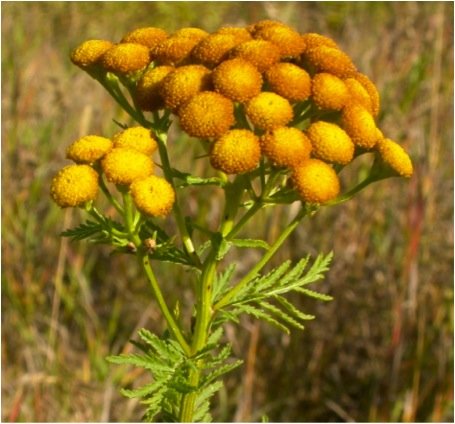 Let’s start with “common”, such as the Common Tansy (one of our most wanted invasive plants). It’s in the Asteraceae Family, and its scientific name is Tanacetum vulgare. Vulgare as in “vulgar”, lacking sophistication or good taste, unrefined. That’s what happens went something becomes too widespread. Many of our so-called weeds have vulgare as their specific name.
Let’s start with “common”, such as the Common Tansy (one of our most wanted invasive plants). It’s in the Asteraceae Family, and its scientific name is Tanacetum vulgare. Vulgare as in “vulgar”, lacking sophistication or good taste, unrefined. That’s what happens went something becomes too widespread. Many of our so-called weeds have vulgare as their specific name. 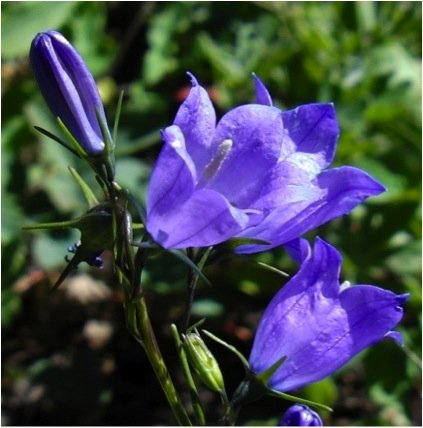 Campanula rotundifolia, Harebell or Blue Bells of Scotland. The common name "harebell" arises from the folk belief that witches used juice squeezed from the flower to turn themselves into hares. The plant is also known as Puck's thimble and was traditionally linked to fairies and witches. "Campanula" is derived from the Latin "campan" for "bell". The species is in the Campanulaceae or Bellflower Family.
Campanula rotundifolia, Harebell or Blue Bells of Scotland. The common name "harebell" arises from the folk belief that witches used juice squeezed from the flower to turn themselves into hares. The plant is also known as Puck's thimble and was traditionally linked to fairies and witches. "Campanula" is derived from the Latin "campan" for "bell". The species is in the Campanulaceae or Bellflower Family. 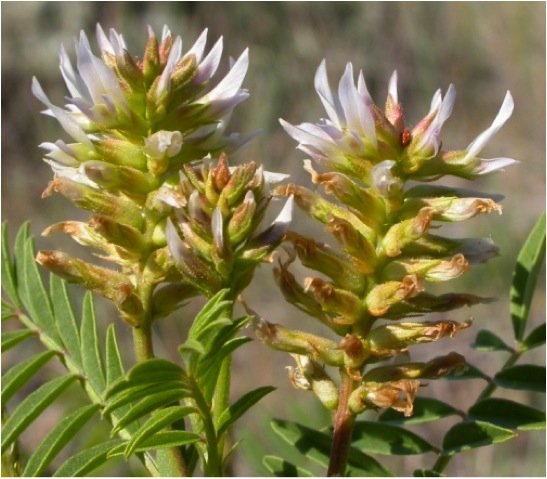 Glycyrrhiza lepidota, Wild Licorice, can be weedy and readily colonizes disturbed soils. In the Fabaceae or Pea Family, the roots are edible and contain glycyrrhizin, with a taste sweeter than sugar. When roasted, roots of Wild Licorice are reported to taste like sweet potato. The generic name "Glycyrrhizais" from the Greek "glykys" for "sweet" and "rhiza" for "root." The bur-like seed pods readily attach themselves to you and your pets.
Glycyrrhiza lepidota, Wild Licorice, can be weedy and readily colonizes disturbed soils. In the Fabaceae or Pea Family, the roots are edible and contain glycyrrhizin, with a taste sweeter than sugar. When roasted, roots of Wild Licorice are reported to taste like sweet potato. The generic name "Glycyrrhizais" from the Greek "glykys" for "sweet" and "rhiza" for "root." The bur-like seed pods readily attach themselves to you and your pets.  Yellow Monkeyflower, Mimulus guttatus (Synonym: Erythranthe guttata), is an eye-catching bright yellow with reddish spots. The plant's sap can be used to heal wounds as it contains agents effective in contracting human tissue. The genus is derived from "mimus" ("buffoon") for the clownish appearance of the flower as you stare into the corolla. "Guttatus" is from the Latin for "drops" or "specks" referring to the tiny red dots on the inside of the petals. Recently reclassified from the Figwort Family (Scrophulariaceae) to the Lopseed Family (Phrymaceae).
Yellow Monkeyflower, Mimulus guttatus (Synonym: Erythranthe guttata), is an eye-catching bright yellow with reddish spots. The plant's sap can be used to heal wounds as it contains agents effective in contracting human tissue. The genus is derived from "mimus" ("buffoon") for the clownish appearance of the flower as you stare into the corolla. "Guttatus" is from the Latin for "drops" or "specks" referring to the tiny red dots on the inside of the petals. Recently reclassified from the Figwort Family (Scrophulariaceae) to the Lopseed Family (Phrymaceae).  The Gunnison's Mariposa Lily or Gunnison's Sego Lily, Calochortus gunnisonii, are members of the Lily Family or Liliaceae. The bulbs of Mariposa-lilies are sweet and nutritious, raw or cooked. There are a number of Mariposa-lily species, primarily distinguished by markings on the inner surface of the petals and the petal colors. "Calochortus", from the Greek "kalos", means "beautiful", and "chortos" means "grass", referring to the grass-like leaves. The plant is named for Captain J. W. Gunnison, 1812-1853, surveyor, explorer, and expedition leader who, with eight companions, was murdered in Utah just after finishing a railroad route survey.
The Gunnison's Mariposa Lily or Gunnison's Sego Lily, Calochortus gunnisonii, are members of the Lily Family or Liliaceae. The bulbs of Mariposa-lilies are sweet and nutritious, raw or cooked. There are a number of Mariposa-lily species, primarily distinguished by markings on the inner surface of the petals and the petal colors. "Calochortus", from the Greek "kalos", means "beautiful", and "chortos" means "grass", referring to the grass-like leaves. The plant is named for Captain J. W. Gunnison, 1812-1853, surveyor, explorer, and expedition leader who, with eight companions, was murdered in Utah just after finishing a railroad route survey. 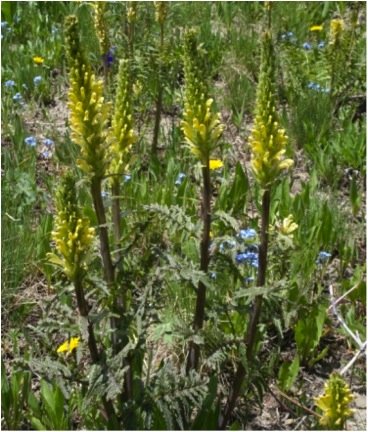 The Fernleaf or Bracted Lousewort, Pedicularis bracteosa, has distinctive, candle-like stalks rise above the surrounding vegetation. Formerly a member of the Scrophulariaceae (Figwort Family), it is now classified as Orobanchaceaee or one of the Broomrapes. The genus name, "Pedicularis", given by Linnaeus in 1753, is derived from the Latin "pediculus" for "lice". A bygone belief had it that the plant gave lice to people and cattle. Or, according to some sources, the plant was thought to cure people or cattle of lice. "Wort" is from the Old English, "wyrt", meaning "plant". Recently reclassified from Figwort Family (Scrophulariaceae) to the Broomrape Family (Orobanchaceae). What’s in a name? A story.
The Fernleaf or Bracted Lousewort, Pedicularis bracteosa, has distinctive, candle-like stalks rise above the surrounding vegetation. Formerly a member of the Scrophulariaceae (Figwort Family), it is now classified as Orobanchaceaee or one of the Broomrapes. The genus name, "Pedicularis", given by Linnaeus in 1753, is derived from the Latin "pediculus" for "lice". A bygone belief had it that the plant gave lice to people and cattle. Or, according to some sources, the plant was thought to cure people or cattle of lice. "Wort" is from the Old English, "wyrt", meaning "plant". Recently reclassified from Figwort Family (Scrophulariaceae) to the Broomrape Family (Orobanchaceae). What’s in a name? A story.
